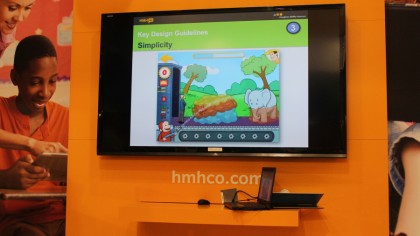Five ways tech is transforming the classroom in 2014
The latest elearning trends from BETT 2014
5. Mobile elearning apps give birth to a new battleground

Schools, much like businesses, had little choice but to embrace the mobile revolution due to the popularity of smartphones and tablets (and difficulty in banning them). Many in the US and Europe operate 'bring your own device' (BYOD) policies that allow students to bring their own devices into classrooms.
Dell's education portfolio includes its Venue 8 Pro and Venue 11 Pro tablets, in addition to its recently unveiled Chromebook 11 that pairs with a web-based management solution to allow school IT departments to configure, load and manage applications for students and teachers.
According to research by Futuresource Consulting, Chromebooks accounted for one in four devices shipped into the US education market in the fourth quarter of 2013. Margaret Franco, Executive Director of End User Computing at Dell, says that having a broad selection of devices on the market allows schools to pick and choose based on the curriculum it follows.
"It depends on the learning experience that the teacher is looking to deliver," she says. "If the curriculum dictates interactive learning through hands-on discovery then a Venue 8 Pro or Venue 11 Pro would suit. Other curricula might dictate learning through test taking, in which case the right answer is a tablet plus a detachable keyboard."
Keeping kids 'appy
Of course, mobile devices - even those designed for elearning - are only as important as the apps that run on them.
James Guinevan, Senior Learning Architect at Houghton Mifflin Harcourt, developer of the Curious George apps, stresses that apps designed for younger children have to be particularly engaging in order to survive.
"When it comes to engagement, which is a vague term, the important things to remember are characters, concept and then reusability or replayability," he says. "It's important that those are done correctly as a lot of development houses often come from PC backgrounds where there's a certain way of doing the user interface."
Are you a pro? Subscribe to our newsletter
Sign up to the TechRadar Pro newsletter to get all the top news, opinion, features and guidance your business needs to succeed!
According to Guinevan, developers can gauge the success of elearning apps through sales, downloads and 'effectiveness', which is measured through feedback provided at the concept stage and throughout the development process.
"There's a lot of expectation from iOS users - particularly those that pay for apps - so you have to make sure they're effective and creative," he says. "You also have to make sure that your company's apps lock-in with your other products, so your app designed for a home tablet should feel the same as the version of it that's used at school, which can be challenging."
